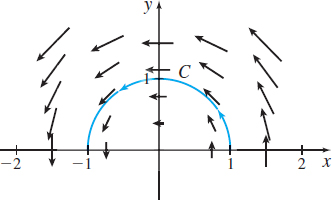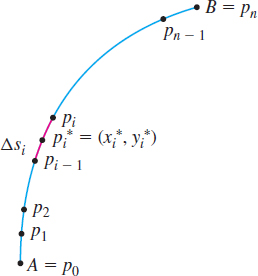15.4 An Application of Line Integrals: WorkPrinted Page 1002
An important application of a line integral is to work. Recall that work is the energy transferred to or from an object by a force acting on the object.
Let's review what we already know about work:
- Constant force: The work W done by a constant force F in moving an object a distance s along a straight line in the direction of F is defined to be \bbox[5px, border:1px solid black, #F9F7ED]{\bbox[#FAF8ED,5pt] { W=Fs }} When the force F acts in the same direction as the motion, the work done is positive; if the force F acts in a direction opposite to the motion, the work is negative.
- Variable force: In Chapter 6, the definition of work was generalized to the case where the force F is variable. The work W done by a variable force F=F(x) acting in the direction of the motion of an object as that object moves along a straight line from x=a to x=b is \bbox[5px, border:1px solid black, #F9F7ED]{\bbox[#FAF8ED,5pt] { W=\int_{a}^{b}F(x)dx }}
- Constant vector force: In Chapter 10, we investigated the work W done by a constant force vector \mathbf{F} acting on an object as that object moves in the direction of a vector \mathbf{r} for a distance \Vert \mathbf{r}\Vert and found that \bbox[5px, border:1px solid black, #F9F7ED]{\bbox[#FAF8ED,5pt] { W=\mathbf{F}\,{\cdot}\, \mathbf{r} }}
- Variable vector force: Now we investigate the work done by a vector field \mathbf{F} (called a force field) acting on an object as that object moves along a smooth curve C from the point A on C to the point B on C.
1003
Suppose \begin{equation*} \mathbf{F}=\mathbf{F}(x,y)=P(x,y)\mathbf{i}+Q(x,y)\mathbf{j} \end{equation*}
is a force field acting on an object at the point (x,y) in some open, connected set R. We assume the functions P and Q have continuous, first-order partial derivatives at each point in R and that C is a smooth curve lying entirely in R. Finally, suppose C is defined by the vector function \begin{equation*} \mathbf{r}=\mathbf{r}(t)=x(t)\mathbf{i}+y(t)\mathbf{j}\qquad a\leq t\leq b \end{equation*}
Partition the closed interval [a,b] into n subintervals \begin{equation*} \lbrack a,t_{1}],\quad \lbrack t_{1},t_{2}],\quad \ldots ,\quad \lbrack t_{i-1},t_{i}],\quad \ldots ,\quad \lbrack t_{n-1},b] \end{equation*}
and denote the length of each subinterval by \Delta t_{1}, \Delta t_{2}, \ldots , \Delta t_{n}. Corresponding to each number a=t_{0}, t_{1}, t_{2}, \ldots , t_{n}=b of the partition, there is a sequence of points A=p_{0}, p_{1}, \ldots , p_{n}=B on the curve C. These points subdivide the curve into n subarcs of lengths \Delta s_{1}, \ \Delta s_{2}, \ldots , \ \Delta s_{n}, as shown in Figure 29.
The norm \Vert \Delta \Vert of the partition is the largest length of the subarcs \Delta s_{i}, i=1, 2, \ldots , n. Let p_{i}^{\ast}=(x_{i}^{\ast },y_{i}^{\ast }) be a point on the ith subarc p_{i-1}p_{i} of C. If the norm \Vert \Delta \Vert is small enough, then the work W_{i} done by the force field \mathbf{F} in moving an object along the arc p{_{i-1}p_{i}} can be approximated by the work done by the constant force \begin{equation*} \mathbf{F}_{i}^{\ast }=\mathbf{F}(x_{i}^{\ast },y_{i}^{\ast }) \end{equation*}
in moving the object along the directed line segment \Delta \mathbf{r}_{i}=\overrightarrow{p_{i-1}p_{i}}. Then \begin{equation*} W_{i}\approx \mathbf{F}_{i}^{\ast }\,{\cdot}\, \Delta \mathbf{r}_{i} \end{equation*}
The total work W done by \mathbf{F} along C from the point A: \mathbf{r}=\mathbf{r}(a) to the point B: \mathbf{r}=\mathbf{r}(b) is W=\lim\limits_{\left\Vert \Delta \right\Vert \rightarrow 0}\sum\limits_{i=1}^{n}W_{i}=\lim\limits_{\left\Vert \Delta \right\Vert \rightarrow 0}\sum\limits_{i=1}^{n}\mathbf{F}_{i}^{\ast }\,{\cdot}\, \Delta \mathbf{r}_{i}. This leads to the following definition:
DEFINITION Work
Let \mathbf{F}=\mathbf{F}(x,y)=P(x,y)\mathbf{i}+Q(x,y)\mathbf{j} be a force field, where the functions P and Q are continuous with continuous partial derivatives at each point of an open, connected set R. Let \mathbf{r}=\mathbf{r}(t), a\leq t\leq b, trace out a piecewise-smooth curve C lying entirely in R. The work W done by the force field \mathbf{F} in moving an object along C is defined as \bbox[5px, border:1px solid black, #F9F7ED]{\bbox[#FAF8ED,5pt] { W=\int_{C}\mathbf{F}\,{\cdot}\, d\mathbf{r}=\int_{C}(P\,dx+Q\,dy) }}
1 Compute WorkPrinted Page 1003
EXAMPLE 1Computing Work
Find the work done by the force field \mathbf{F}(x,y)=-y\mathbf{i}+x\mathbf{j} in moving an object along the half-circle C traced out by \mathbf{r}(t)=\cos t\,\mathbf{i}+\sin t\,\mathbf{j}\qquad 0\leq t\leq \pi
1004
Solution On C, x(t)=\cos t and y(t)=\sin t, 0\leq t\leq \pi. Then \begin{eqnarray*} \mathbf{F}( x(t),y(t)) & =&-y(t) \mathbf{i}+x(t) \mathbf{j}=-\sin t\,\mathbf{i}+\cos t\,\mathbf{j}\hbox{}\\ d\mathbf{r}(t)& =&( -\sin t\,\mathbf{i}+\cos t\,\mathbf{j}) \,dt \\[4pt] \mathbf{F}\,{\cdot}\, d\mathbf{r}& =&(\sin ^{2}t+\cos ^{2}t)\,dt=dt \end{eqnarray*}
The work W done by \mathbf{F} is W=\int_{C}\mathbf{F}\,{\cdot}\, d\mathbf{r}=\int_{0}^{\pi }dt=\pi

See Figure 30 for the force field \mathbf{F}(x,y)=-y\mathbf{i}+x\mathbf{j} and the curve C.
NOW WORK
Work and Kinetic Energy
The work W done by a force field \mathbf{F} in moving an object along a piecewise-smooth curve C traced out by \mathbf{r}=\mathbf{r}(t), a\leq t\leq b, is \bbox[5px, border:1px solid black, #F9F7ED]{\bbox[#FAF8ED,5pt] { W=\int_{C}\mathbf{F}\,{\cdot}\, d\mathbf{r}=\int_{a}^{b}\mathbf{F} \,{\cdot}\, \mathbf{r}' (t)\,dt }}
Using Newton's Second Law of Motion, \mathbf{F}=m\mathbf{r}'' (t), where \mathbf{r}'' (t) is the acceleration of the object, we find that work W can be expressed as \begin{eqnarray*} W=\int_{a}^{b}\mathbf{F}\,{\cdot}\, \mathbf{r}' (t)\,dt&\underset{\underset{\color{#0066A7}{\mathbf{F}=m\mathbf{r}'' (t)}}{\color{#0066A7}{\uparrow }}}{=}&\int_{a}^{b}m \mathbf{r}'' (t)\,{\cdot}\, \mathbf{r}' (t)\,dt\underset{\underset{\color{#0066A7} {\dfrac{d}{dt}[\mathbf{r}' (t)\,{\cdot}\, \mathbf{r}' (t)]=2 [\mathbf{r}'' (t)\,{\cdot}\, \mathbf{r}' (t) ]}}{\color{#0066A7}{\uparrow }}}{=}\dfrac{m}{2}\int_{a}^{b}\dfrac{d}{dt}[ \mathbf{r}^{\prime }(t)\,{\cdot}\, \mathbf{r}^{\prime }(t)]\,dt \nonumber\\ &\underset{\underset{\color{#0066A7}{\mathbf{r}^{\prime }\!\cdot\!\mathbf{r}^{\prime } = \left\Vert \mathbf{r}^{\prime }\right\Vert ^{2}}}{\color{#0066A7}{\uparrow }}}{=}&\dfrac{m}{2}\int_{a}^{b}\dfrac{d}{dt}\left\Vert \mathbf{r}' (t) \right\Vert ^{2}dt=\left. \dfrac{m}{2}\left\Vert \mathbf{r' (t)}\right\Vert ^{2}\right] _{a}^{b}\tag{1} \end{eqnarray*}
Kinetic energy K is the energy of motion. The kinetic energy K of an object of mass m that moves along a curve with speed \left\Vert \mathbf{v} \right\Vert is given by \begin{eqnarray*}\bbox[5px, border:1px solid black, #F9F7ED]{\bbox[#FAF8ED,5pt] {{ K=\dfrac{1}{2}m\Vert \mathbf{v}\Vert ^{2}\underset{\underset{\color{#0066A7}{\hbox{\(\mathbf{v}=\mathbf{r}' (t)\)}}}{\color{#0066A7}{\uparrow}}}{=}\dfrac{m}{2}\left\Vert \mathbf{r' (t)}\right\Vert ^{2} \\[-6.3pt] }}} \tag{2} \end{eqnarray*}
By combining (1) and (2), we obtain \bbox[5px, border:1px solid black, #F9F7ED]{\bbox[#FAF8ED,5pt] { W=K(b)-K(a) }}
which relates work W to kinetic energy K. In other words, \bbox[5px, border:1px solid black, #F9F7ED]{\bbox[#FAF8ED,5pt] { \left[ \begin{eqnarray*} \hbox{Work \(W\) done by a force field \(\mathbf{F}\)} \\ \hbox{in moving an object from \(a\) to \(b\)} \end{eqnarray*}\right] = [ \hbox{Change in the kinetic energy \(K\) from \(a\) to \(b\)}] }}
If the curve C is closed and the force field \mathbf{F} is conservative, then it follows that \bbox[5px, border:1px solid black, #F9F7ED]{\bbox[#FAF8ED,5pt] { \hbox{Work} =\int_{C}\mathbf{F}\,{\cdot}\, d\mathbf{r}=0 }}
THEOREM Work on a Closed Path
In a conservative force field \mathbf{F}, the work W done by \mathbf{F} in moving an object along a closed path is 0. That is, the object returns to its original position with the same kinetic energy it started with.
1005
The work done by a conservative force field \mathbf{F} is independent of the path. Physicists paraphrase this by saying that, in a conservative force field, work is a function of position and not path.
Gravitational force is an example of a conservative force field. But not all forces \mathbf{F} are conservative, as we show in Example 2.
EXAMPLE 2Showing a Force Field Is Not a Conservative Vector Field
- (a) Show that the force field \mathbf{F}=( x+y) \mathbf{i} +( y-x) \mathbf{j} is not a conservative vector field.
- (b) Show that the work W done by \mathbf{F} in moving an object is dependent on the path by using two paths starting at the origin (0,0) and ending at the point (1,1).
Solution (a) Let P(x,y) =x+y and Q(x,y) =y-x. Then \dfrac{\partial P}{\partial y}=\dfrac{\partial }{\partial y}(x+y) =1\qquad\hbox{and}\qquad \dfrac{\partial Q}{\partial x}=\dfrac{\partial }{\partial x}(y-x) =-1
Since \dfrac{\partial P}{\partial y}\neq \dfrac{\partial Q}{\partial x}, the force field \mathbf{F} is not a conservative vector field.
(b) To show that the work W done by \mathbf{F} is dependent on the path, we choose two paths beginning at the origin (0,0) and ending at the point (1,1).
For Path 1, we let C be defined by y=x, where 0\leq x\leq 1. That is, x(t) =t, y(t) =t, 0\leq t\leq 1. Then \mathbf{F}( x(t),y(t)) =2t\,\mathbf{i}, \mathbf{r}(t) =t\mathbf{i}+t\mathbf{j}, and d\mathbf{r=\,}\left( \mathbf{i}+\mathbf{j}\right) dt. So, \begin{equation*} \mathbf{F}\,{\cdot}\, d\mathbf{r}=2t\,dt \end{equation*}
The work W done by \mathbf{F} along C is W=\int_{C}\mathbf{F}\,{\cdot}\, d\mathbf{r}=\int_{0}^{1}2t\,dt=\big[ t^{2}\big] _{0}^{1}=1
For Path 2, we let C be the piecewise-smooth curve made up of:
- C_{1}, which is traced out by x(t) =t, y(t) =0, 0\leq t\leq 1, and
- C_{2}, which is traced out by x(t) =1, y(t) =t, 0\leq t\leq 1.
For C_{1}, \mathbf{F}( x(t),y(t)) =t\,\mathbf{i}-t\mathbf{j}, \mathbf{r}(t) =t\mathbf{i}, and d\mathbf{r}=\mathbf{i}\,dt. So, \mathbf{F}\,{\cdot}\, d\mathbf{r}=t\,dt
For C_{2}, \mathbf{F}( x(t),y(t)) =( 1+t) \,\mathbf{i}+( t-1) \mathbf{j}, \mathbf{r}(t) =\mathbf{i}+t \mathbf{j}, and d\mathbf{r}=\mathbf{j}\,dt. So, \begin{equation*} \mathbf{F}\,{\cdot}\, d\mathbf{r}=( t-1)\, dt \end{equation*}
The work W done by \mathbf{F} along Path 2 is \begin{equation*} W=\int_{C_{1}}\mathbf{F}\,{\cdot}\, d\mathbf{r}\,+\int_{C_{2}}\mathbf{F}\,{\cdot}\, d \mathbf{r}=\int_{0}^{1}t\,dt +\int_{0}^{1}( t-1)\, dt=0 \end{equation*}
Since the work done along Path 1 and Path 2 are not equal, the work W done by the force \mathbf{F} is dependent on the path.
NOW WORK
NOTE
Potential energy U is the energy of position in a system.
Work and Potential Energy
Suppose an object of mass m moves along a smooth curve C traced out by \mathbf{r}=\mathbf{r}(t), a\leq t\leq b, in a conservative force field \mathbf{F}=\mathbf{F}(x,y). The potential energy U=U(x,y) of the object due to \mathbf{F} is the function U for which \bbox[5px, border:1px solid black, #F9F7ED]{\bbox[#FAF8ED,5pt] { \nabla U=-\mathbf{F} }}
1006
That is, U is the negative of the potential function for \mathbf{F}. The work W done by \mathbf{F} in moving an object along C from a to b is \begin{eqnarray*} W=\int_{C}\mathbf{F}\,{\cdot}\, d\mathbf{r}=-\int_{C}{\nabla }U\,{\cdot}\, d\mathbf{r}=- \big[U(x,y)\big] _{a}^{b}=- [U ( \mathbf{r} ( b) ) -U ( \mathbf{r} ( a) ) ] =U ( \mathbf{r} ( a) ) -U ( \mathbf{r}(b)) \end{eqnarray*}
This equation relates work W to potential energy U, as stated below. \bbox[5px, border:1px solid black, #F9F7ED]{\bbox[#FAF8ED,5pt] { \left[ \begin{eqnarray*} \hbox{The work \(W\) done by a force field \(\mathbf{F}\)} \\ \hbox{in moving an object from \(a\) to \(b\)} \end{eqnarray*}\right] =[\hbox{The change in potential energy \(U\) from \(b\) to \(a\)}] }}
Now we can state and prove the Law of Conservation of Energy.
Law of Conservation of Energy
In a conservative force field \mathbf{F}, the sum of the potential and kinetic energies of an object is constant.
Proof
The potential energy U=U(x,y) of an object moving along a curve C in a conservative field of force \mathbf{F} obeys \begin{equation*} {\nabla }U=-\mathbf{F}(x,y) \end{equation*}
If an object of mass m moves along the curve C traced out by \mathbf{r}=\mathbf{r}(t), a\leq t\leq b, its kinetic energy K is \begin{equation*} K=\dfrac{1}{2}m\left\Vert \mathbf{r}' (t) \right\Vert ^{2}= \dfrac{1}{2}m[\mathbf{r}' (t)\,{\cdot}\, \mathbf{r}' (t)] \end{equation*}
Let E=E(t) equal the sum of the potential and kinetic energies of the object at time t. Then \begin{equation*} E(t)=U+K=U(x,y)+\dfrac{m}{2}[\mathbf{r}' (t)\,{\cdot}\, \mathbf{r}' (t)] \end{equation*}
We show that E is constant by showing that E' (t)=0: \begin{eqnarray*} E' (t)\underset{\underset{\color{#0066A7}{\hbox{Use Chain Rule I with \(U\)}}}{\color{#0066A7}{\uparrow}}}{=} \dfrac{\partial U}{\partial x}\dfrac{dx}{dt}+\dfrac{\partial U}{\partial y} \dfrac{dy}{dt}+m[\mathbf{r}' (t)\,{\cdot}\, \mathbf{r}'' (t)]\\[-9.5pt] \end{eqnarray*}
But \begin{eqnarray*} \mathbf{r}' (t)=\dfrac{dx}{dt}\,\mathbf{i}+\dfrac{dy}{dt}\,\mathbf{j} \qquad \hbox{and}\qquad \dfrac{\partial U}{\partial x}\mathbf{i}+\dfrac{ \partial U}{\partial y}\mathbf{j}={\nabla }U=-\mathbf{F}\underset{\underset{\color{#0066A7}{\hbox{\(\mathbf{F}\,=\,m\mathbf{a}\)}}}{\color{#0066A7}{\uparrow}}}{=}-m\mathbf{r}'' (t) \end{eqnarray*}
So, \dfrac{\partial U}{\partial x}\dfrac{dx}{dt}+\dfrac{\partial U}{\partial y} \dfrac{dy}{dt}={\nabla }U\,\cdot\, \mathbf{r}' (t) =-m\,\mathbf{r}'' (t) \,\cdot\, \mathbf{r}' (t)
Then \begin{equation*} E' (t)=-m[\mathbf{r}'' (t)\,{\cdot}\, \mathbf{r}' (t)]+m[ \mathbf{r}' (t)\,{\cdot}\, \mathbf{r}'' (t)]=0 \end{equation*}
That is, the energy E of the object is constant.
